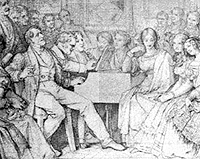genre: Sonata
 The sonata is, along with the symphony and the concerto, a staple of the instrumental performance repertoire, and a medium of outstanding creative energy since the early Baroque. The term “sonata” stems from the Italian word sonare – to sound – and has since the late-16th century specified a work to be played on instruments, as opposed to a cantata, which is to be sung. The term first became common in the late Renaissance for solo lute works, as well as for works for a small ensemble and continuo, such as Giovanni Gabrielli’s Sonata 'con tre violini' (1615). As the Baroque era progressed the sonata became increasingly popular, and was commonly divided into two types, the sonata da chiesa (or “church sonata”) – a group of 4 movements, alternating slow-fast-slow-fast; and the sonata da camera (or “chamber sonata”) – an opening slow movement followed by a set of dances. A significant development, both for the genre of the sonata and the evolution of so-called “sonata form”, was the stunning output of 555 sonatas for solo keyboard written at the end of the Baroque era by Domenico Scarlatti; while only single movement works, these sonatas established the penchant for the binary harmonic progression of I-V; V-I that was to become standard for first movements – not only in sonatas, but in such genres as the symphony and concerto. The sonata reached perhaps its zenith in the Classical and early Romantic eras, and in particular in the solo piano sonatas of Franz Joseph Haydn, Wolfgang Amadeus Mozart, and Ludwig van Beethoven; these works are generally in 4 movements (thus adopting the sonata da chiesa model), with the first movement being in “sonata form.” While the solo piano sonata held special importance, sonatas featuring other instruments – especially the violin and cello – with piano accompaniment, were likewise popular; these “chamber sonatas” too are generally 4 movements with the first in sonata form. The sonata continued to hold sway throughout the late-Romantic era, as in those by Franz Schubert, Frédéric Chopin, Johannes Brahms, and Franz Liszt, and indeed most composers of the Modern era wrote solo piano and/or chamber sonatas, as in those by Alban Berg, Igor Stravinsky, Sergey Prokofiev, Paul Hindemith, etc. – though the requisite use of sonata form for the first movement weakened in conjunction with tonality’s decline. By all accounts, however, the genre of the sonata appears alive and well even today.
The sonata is, along with the symphony and the concerto, a staple of the instrumental performance repertoire, and a medium of outstanding creative energy since the early Baroque. The term “sonata” stems from the Italian word sonare – to sound – and has since the late-16th century specified a work to be played on instruments, as opposed to a cantata, which is to be sung. The term first became common in the late Renaissance for solo lute works, as well as for works for a small ensemble and continuo, such as Giovanni Gabrielli’s Sonata 'con tre violini' (1615). As the Baroque era progressed the sonata became increasingly popular, and was commonly divided into two types, the sonata da chiesa (or “church sonata”) – a group of 4 movements, alternating slow-fast-slow-fast; and the sonata da camera (or “chamber sonata”) – an opening slow movement followed by a set of dances. A significant development, both for the genre of the sonata and the evolution of so-called “sonata form”, was the stunning output of 555 sonatas for solo keyboard written at the end of the Baroque era by Domenico Scarlatti; while only single movement works, these sonatas established the penchant for the binary harmonic progression of I-V; V-I that was to become standard for first movements – not only in sonatas, but in such genres as the symphony and concerto. The sonata reached perhaps its zenith in the Classical and early Romantic eras, and in particular in the solo piano sonatas of Franz Joseph Haydn, Wolfgang Amadeus Mozart, and Ludwig van Beethoven; these works are generally in 4 movements (thus adopting the sonata da chiesa model), with the first movement being in “sonata form.” While the solo piano sonata held special importance, sonatas featuring other instruments – especially the violin and cello – with piano accompaniment, were likewise popular; these “chamber sonatas” too are generally 4 movements with the first in sonata form. The sonata continued to hold sway throughout the late-Romantic era, as in those by Franz Schubert, Frédéric Chopin, Johannes Brahms, and Franz Liszt, and indeed most composers of the Modern era wrote solo piano and/or chamber sonatas, as in those by Alban Berg, Igor Stravinsky, Sergey Prokofiev, Paul Hindemith, etc. – though the requisite use of sonata form for the first movement weakened in conjunction with tonality’s decline. By all accounts, however, the genre of the sonata appears alive and well even today.

Nolan Gasser, PhD
Artistic Director













